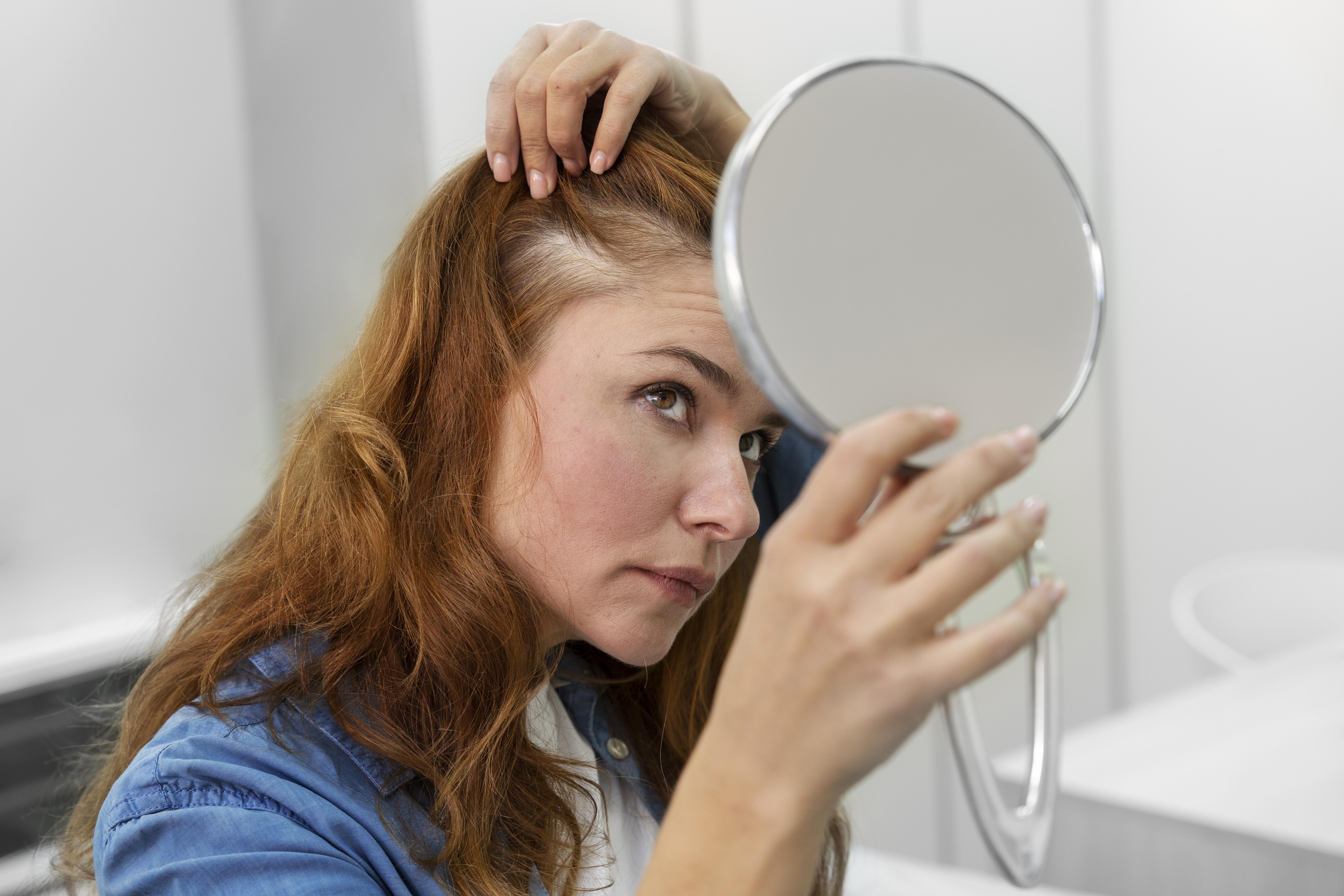Last Updated on: 17th September 2023, 11:03 pm
Female pattern hair loss can be harder to identify compared to male pattern hair loss.
Women experience hair loss when new hair doesn’t replace the hair that has fallen out.
In general, baldness occurs when the hair follicle shrinks over time, resulting in shorter and finer hair.
However, as long as the follicles remain alive, it is still possible to grow new hair.
The reason for female pattern baldness is not well understood but may be related to:
- Genetic hair loss (from family history of male or female pattern hair loss)
- Changes in the levels of androgens (hormones that can stimulate male features)
- Heavy loss of blood during menstrual periods
- Certain medicines, such as stopping oral contraceptive pills
- telogen effluvium (usually caused by stress, weight loss or post child birth)
- Vitamin d deficiency
- Fungal infection
- Nutrient deficiency
How to identify female pattern hair loss?
Hair loss in women happens mainly on the top and crown areas of the scalp.
It is usually known as androgenetic alopecia which begins with gradual thinning at the part line, followed by increasing diffuse hair loss radiating from the top of the head.
There are times when the pattern of the thinning hair forms a pattern of hair loss that looks like a Christmas tree.
Hair fall around the front hairline is considered normal hair physiology that happens to everyone as time passes.
This sort of hair loss rarely progresses to total or near total baldness, as it may in men.
Hormonal imbalances can cause female hair loss especially when there is an increase in androgens where the hair on the head is thinner while the hair on the face is coarser.
Itching or skin sores on the scalp are generally not seen.
Other potential causes that trigger hair loss in women include medical conditions, medications, and physical or emotional stress.
What a medical practitioner does to identify hair loss in women?
Female pattern baldness is usually diagnosed based on:
- Ruling out other causes of hair loss, such as thyroid disease or iron deficiency.
- The appearance and pattern of hair loss.
- Your medical history.
The healthcare provider will perform tests to identify the cause of hair thinning.
If hair loss occurs due to an overload of male hormones, then they will be able to see:
- Abnormal new hair growth, such as on the face or between the belly button and pubic area
- Changes in menstrual periods and enlargement of the clitoris
- Fresh acne
It is also common to perform a skin biopsy of the scalp and a follicular unit extraction on the affected scalp to understand hair loss patterns and to identify what is causing significant hair loss in women.
Looking at the hair with a dermoscope or under a microscope may be done to check for problems with the structure of the hair shaft itself.
What female hair loss treatments are available?
Oftentimes, hair loss in women is mild to moderate and can be hidden with hair styling.
However, if there is severe hair loss that may result in permanent hair loss in women, there are medicines available to stimulate hair growth.
1) What medicines are available for hair regrowth?
The most popular medicine to treat any hair loss is minoxidil.
Minoxidil is applied directly to the scalp and the 2% solution or 5% foam is recommended as part of female hair loss treatments.
This medicine can be used for a long time to slow hair loss or encourage hair growth.
If minoxidil does not work, your healthcare provider may recommend other medicines, such as spironolactone, cimetidine, birth control pills, ketoconazole, and others.
2) Hair transplant surgery
If medication does not help with female pattern hair loss, hair transplant is the next solution for you.
This procedure can be effective in females:
- Who does not respond well to medical treatment
- With no significant cosmetic improvement
During hair transplants, tiny plugs of hair are removed from areas with thicker hair density, and hair transplantation is done in areas that are balding.
Although results from hair transplant surgery are often excellent and permanent to treat hair loss, minor scarring may occur from areas where hair is removed and there is a slight risk for skin infection.
3) What else can you do to reduce hair fall?
Having regular scalp massages to increase hair growth and improve blood flow can help stimulate hair growth.
Using oils such as coconut oils can improve hair health and strengthen hair strands for healthy hair.
It is also important to look into your diet to make sure you are eating enough protein.
As our hair is made mainly from protein, it needs enough of it to remain healthy and encourage regrowth.
Foods you can eat to improve your hair health include:
- eggs
- berries
- spinach
- fatty fishes
- sweet potatoes
- avocados
- nuts
- seeds
- sweet peppers
- oysters
- beans and soybeans
- meat
These tips may help you avoid preventable types of hair loss:
Remember to be gentle with your hair.
Use a detangler and avoid tugging when brushing and combing, especially when your hair is wet.
A wide-toothed comb might help prevent pulling out hair.
It is also common to lose hair when you use too many harsh hair treatments such as hot rollers, curling irons, bleaching, perming, and straightening your hair.
There are also hairstyles that cause tension on hair which results in thinning hair around the pulled areas.
You can choose silk scrunchies to prevent hair breakage that is often caused by rubber bands, barrettes, and braids.
We have all heard about how bad UVA and UVB rays can be on your skin but did you know it can also cause damage to your hair strands and hair follicles?
You can opt for spray-on sunscreen or wrap your hair in a silk scarf or wear a hat to protect it from direct sunlight.
Chlorine from swimming can damage your hair.
Remember to wet your hair before entering the pool to prevent your hair from absorbing more chlorine.
If you’re being treated with chemotherapy, ask your doctor about a cooling cap.
This cap can reduce your risk of losing hair during chemotherapy.






